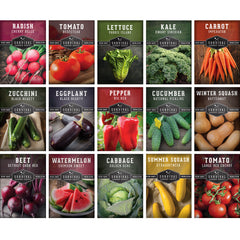Cover crops, also known as green manure, are plants grown in your garden to improve soil conditions. These crops are often planted at the beginning or end of the growing season to restore nutrients to the soil. They are typically cut down and turned into the soil and left to decompose restoring nitrogen and preventing pests like parasitic nematodes
Several types of plants that are used as cover crops. Some are winter hardy and others will be killed by cold weather, so it is important to choose the right type of cover crop seed for your garden and the season. Many of these cover crops can also be harvested as food crops or used as forage if you time things just right, but you’ll need to be careful with your timing and do your best to prevent any reseeding..
Cover Crop Types

Brassicas
Brassicas are plant members of the mustard and cabbage family. They are typically winter-hardy (able to withstand freezing temperatures). They grow quickly and fix nitrogen that is released back into the soil when they decompose. Brassicas excel at weed suppression and release compounds that deter pests. Root vegetables in this family (turnips and radishes) also help to break up compacted soil. Some examples of Brassicae used for cover crops are arugula, mustard greens, and daikon radish. Brassicas are best planted from mid-August to mid-September.
Grains and Grasses
Grains and grasses often used for cover crops include cereal grains like barley, buckwheat, oats, wheat, and rye. Grains and grasses benefit the soil because they have dense, fibrous roots that help prevent soil erosion and their thick growth suppresses weeds. Most grains, other than winter rye and wheat, will be killed by cold weather, so it is best to plant them by the end of the summer up to mid-September.
Legumes
Legumes are flowering members of the pea family that typically provide a thick covering of foliage and break down quicker than brassicas or grasses making your garden beds ready for early Spring planting. A popular legume used as a winter cover crop is Crimson Clover. Most legumes should generally be planted by late September or early October.
Choosing Your Cover Crops

The type of cover crop you choose will depend on the condition of your soil and what you plan to plant after the cover crops. If you need to work on preventing erosion or breaking up hard soil, then brassicas and grains are a good option. If you need to replace nitrogen for heavy feeders like peppers and tomatoes, then you will want to plant some legumes. When in doubt, buckwheat is a great option to start with. It grows so quickly that you can do multiple plantings between your other crops.
Another consideration is your location and environment. Brassicas can give off a sulfur odor when decomposing that may annoy your neighbors and deer love tender legumes like crimson clover. Just like the rest of the plants you grow in your garden, you may want to experiment with different cover crops to find what works best for you.
How to Sow Cover Crops
Planting cover crops is a pretty straightforward process.
- Remove any remaining debris from previous crops as well as any weeds
- With a garden fork or spade, dig into the ground to a depth of about 12 inches, turning the soil and breaking up any big clumps.
- Rake your soil smooth and scatter seeds based on the sowing directions being careful not to sow too thickly.
- Gently rake your seeds into the soil and water to settle the seeds
Cover crops grow quickly on warm days and cool nights at the end of Summer, and early Fall. They generally don’t need additional watering because the fall season is usually wetter.
When to Terminate Your Cover Crops

As painful as it sounds, one of the purposes of cover crops is to terminate them at the right time so that they can benefit your soil the most. Ideally, you’ll want your cover crops to establish abundant foliage and for some, even begin to flower. Unless you plan on harvesting them as a food crop, they should be killed before those flowers go to seed. Otherwise, you will be planting more cover crops in your garden by tilling in those seeds instead of making room for new plants. Most cover crops need four to eight weeks to develop healthy roots and foliage.
How to Terminate Your Cover Crops
Winter-killed crops will be dealt with by the weather. You’ll simply leave the dead plants in the garden to act as mulch and decompose, then till them into the soil in the spring.
For the home gardener, the simplest way to kill winter-hardy cover crops is to use a lawn mower or string trimmer to cut plants close to the soil surface and leave the cut foliage on the ground to form a mulch for a no-till method. By doing this, the benefits of living roots in your soil will continue to build the organic matter and diversity in your soil. If you prefer to till, the plant matter can be directly incorporated into the soil as fertilizer.
You’ll want to allow two to four weeks for your tilled plants to decompose before planting again.
Natural Soil Improvement
Planting cover crops is a more natural, non-invasive way to fertilize and improve your soil. With a little planning and effort, you can create a happy soil microbiome that will produce happy, healthy plants for you and your family. Our cover crop seed selections are a great place to get started!
























